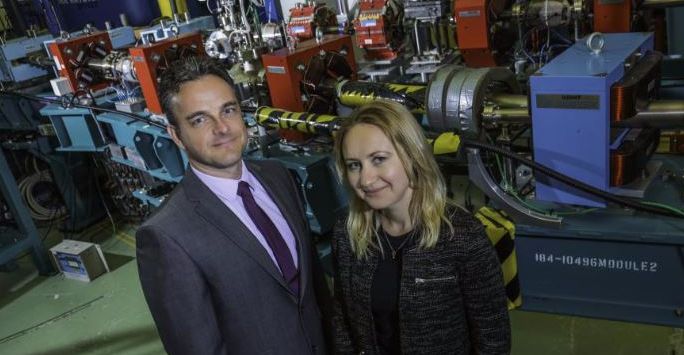Liverpool spin-out makes light of beam control

New Start up D-Beam joins the STFC CERN Business Incubation Centre
A light detector that tells you exactly where and when you lost a tiny particle in a kilometre-long accelerator is the first commercial device to be developed by D-Beam, a spinout from the Cockcroft Institute. The start-up has world leading expertise in beam diagnostic and has become one of the first companies to join the STFC CERN Business Incubation Centre (STFC CERN BIC).
Professor Carsten Welsch, is one of the two D-Beam founders and Head of Physics. He explains how frustration led him to set-up the company: “So far, we have developed beam diagnostic devices as prototypes, have developed them, built them, tested them, shown that they are working, but then we had to let the technology go because a university group should not oversee producing specific instruments for wider markets.”
“D-Beam will be able to translate cutting edge research into commercially available tools that will improve our understanding and control of particle beams.”
Particle beams are used in cancer treatment, such as the new proton therapy service due to open Liverpool’s Knowledge Quarter in 2019 as announced recently, as well as facilities such as the Large Hadron Collider and European Spallation Source. This is an emerging area and D-Beam will offer a step-change in precision for the hundreds of large accelerators and synchrotron light sources that are currently in operation worldwide.
The idea for the accelerator science incubation centre came from STFC in Daresbury, which set up the first facility to support the commercialisation of technologies emerging from CERN. Following its success in the UK the concept has now been rolled out across Europe.
D-Beam has world leading expertise in particle beams diagnostics, developed through intense and long lasting research collaborations with CERN. D-Beam will also have access to specific parts of CERN intellectual property through the STFC CERN BIC.
Particle beams are streams of particles, such as electrons, protons or heavy ions. Measuring and monitoring the behaviour of these beams is the focus of Prof Welsch’s research team. He explains: “My QUASAR Group is developing beam diagnostics. Our goal is to measure whatever kind of particle beam we're given - electrons, antiprotons, protons, heavy ions: whatever beam, whatever energy, we want to measure it better than anybody else.”
The company’s first commercial device will be based on a new type of sensors that can monitor the “halo” of particles lost by a beam. Such losses can range from being annoying “noise” in experiments to causing damages to these expensive machines.
The new sensors use optical fibres fitted with advanced photo detectors; each time a stray particle crosses a fibre, it creates a light pulse that can be recorded with extreme precision, giving both a high temporal and spatial resolution. The product has been tested in a synchrotron in Australia and achieved the best time resolution for this device.
“Another product we are considering for commercialisation is a gas jet based monitor that can characterise the profile of the beam, another key feature that needs constant surveillance,” explains Prof Welsch.
The monitor uses a cold (< 20 K) neutral supersonic gas jet shaped into a thin curtain. This crosses the path of the beam at a 45-degree angle. When the beam particles hit the atoms of the gas, light is generated which creates a “photograph” of the beam’s profile. The method is so advanced that the next upgrade of the Large Hadron Collider, the largest and most powerful accelerator in the world, shall be fitted with this detector.
Prof Welsch: “We come from academic research, where the driver is always to do better, to measure more precisely, to maybe measure something that nobody has ever measured before. At the same time the results we get also lend themselves very well to real world applications.”
The arrival on the market of these ground-breaking technologies is expected to bring significant changes in the field, improving the precision and ease of use of these powerful devices and opening up new opportunities for science and society.
